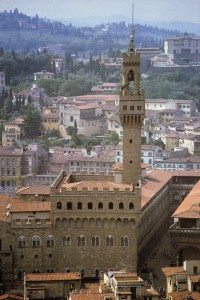WEEK 26
On and around the year 1000 AD, the cities of Europe, and especially of Italy, turned a corner. After centuries of war and invasion, almost suddenly, there was peace. Travel on land and sea became safer. Products moved around more easily. People moved around more easily. And thus during the Eleventh Century, there was a general resurgence of the European economy and especially that of the cities. The cities grew fast. They expanded fast. They built bigger walls. They built huge new cathedrals and huge new city halls like the building on the right, the Palazzo Vecchio in Florence. In order to understand this phenomenon we will take one Italian city, Florence, and tell its story from the end of the Roman Empire in the sixth century to the great expansion of the twelfth and thirteenth centuries. Of all the possible choices for our study, Florence has a major advantage for our study: it was a Roman founded city, it declined as Rome declined, it surged back as all of Europe and Italy rebounded in the eleventh century. Its trajectory reveals exactly the Italian story of so many other cities.
RECOMMENDED READING
This two-volume history of Florence is the best detailed study of Florence ever written. Schevill wrote a masterpiece of well researched narrative history for Florence in 1936 and then it was republished in a Harper Torchbook paperback in 1961. The Harper Torchbook is still out there in used book stores so we have purchased five for our library. But there are still copies left if you want to own one. It is two volumes with the first volume devoted to our period of Medieval History and the second volume on Renaissance Florence. For the Lombards see Medieval Florence (Volume 1) Chapter Three, "Darkness Over Florence."

Ferdinand Schevill,
Medieval and Renaissance Florence,
Harper Torchbook paperback, 1963, 2 volumes,
ISBN B000PX4SUU
